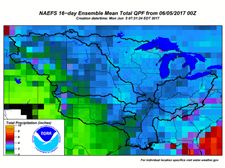Good evening,
This past week I had the opportunity to travel to Ashtabula County in the extreme northeast corner of the state for the OSU Extension Agriculture and Natural Resources Summer Retreat. We had several meetings and speakers while there, but the best part of the event were the production agriculture, agribusiness, and horticulture tours of the diverse operations that the county has. One thing that I did see there that was similar to Hardin County were several fields of hay mowed for the first time. Coming back to the local area on Friday, I saw that several farmers were still planting soybeans here. This past week I submitted an article to the media on recommendations for planting late soybeans. The attached news article was written by OSU Extension Soybean and Small Grains Specialist Laura Lindsey.
Late Planted Soybeans News Release
Saturday we weighed and tagged 102 head of market lambs for the Hardin County Fair. Thanks to the 4-H and FFA members, parents, Sheep Improvement Association, and Fairboard for making this weekend’s event run smoothly. The new small animal show arena has been built on the fairgrounds beside the sheep barn, providing a place for goats, rabbits, and poultry to be shown. This past week I counted an average of 6 armyworm and 3 black cutworm moths in the traps near LaRue, Ridgeway, and Alger. They still are low in numbers in the area, but are able to travel quite a distance before laying eggs. Check for clipped corn near the soil or feeding at the base of the corn whirl for evidence of larvae damage. Several people have been replanting both corn and soybeans and many of the stands look thin in areas due to the weather. There is a wide variety of growth stages in the crops that are up, so hopefully we will receive favorable weather from this point forward.
Upcoming events this week include a rescheduled June Fairboard meeting Wednesday, June 14 at the fair office, starting at 7:30 pm, and a Soil and Water Conservation District meeting Thursday, June 15, starting at 7:30 am at the SWCD office. I have included some agronomy articles below for your reading if you have a nice cool place to go and relax.
Mark

Weather Outlook – Jim Noel
A pattern change appears underway. We are heading into a summer type pattern that continues to evolve as we speak. This will mean a transition to warmer weather with rainfall becoming much more scattered and sporadic. Some areas will still receive locally heavy rainfall but other places will get missed. Go to https://agcrops.osu.edu/newsletter/corn-newsletter/2017-16/weather-outlook to read more about the weather forecast for the rest of June.
Will Planting Delays Require Switching Corn Hybrid Maturities? – Peter Thomison
According to the USDA/NASS (https://www.nass.usda.gov/Statistics_by_State/Ohio/Publications/Crop_Progress_&_Condition/2017/cw2117oh.pdf), for the week ending May 21, corn was 73 percent planted, which was 24 percent ahead of last year and the same as the five-year average. However, persistent rains and saturated soil conditions have resulted in replanting and delayed corn planting. To read more about when to switch corn varieties due to late planting, go to https://agcrops.osu.edu/newsletter/corn-newsletter/2017-14/will-planting-delays-require-switching-corn-hybrid-maturities.

How You Can Help the Sun Make Hay When It Shines! – Mark Sulc
Editor’s note: Most of this article is adapted with permission from an article published in Farm and Dairy on 2nd June 2010, available at http://www.farmanddairy.com/top-stories/make-hay-when-sun-shines-but-take-steps-in-case-weather-wont-cooperate/15050.html. It still applies now. In an another article I’ve encouraged patience in waiting for soils to firm up before attempting to make our first cutting of hay after the heavy rains we received over a previous weekend. Once the soils are firm enough, there are several proven techniques that can speed up the hay curing process. If you are looking for methods to speed up the hay-making process, go to https://agcrops.osu.edu/newsletter/corn-newsletter/2017-14/how-you-can-help-sun-make-hay-when-it-shines.

Did you calibrate your sprayer? Here is an easy way to do it – Erdal Ozkan
Hopefully you have calibrated your sprayer during early spring, before the busy spring activities have started. There is still plenty of spraying to be done in months ahead of us. So, if you have not calibrated your sprayer yet, take care of this very important task if you want to effectively protect your crops against weeds, insects and diseases. One can determine if the chemicals are applied at the proper rate, only by carefully calibrating the sprayer. While applying too little pesticide may result in ineffective pest control, too much pesticide wastes money, may damage the crop and increases the potential risk of contaminating ground water and environment. Go to https://agcrops.osu.edu/newsletter/corn-newsletter/2017-15/did-you-calibrate-your-sprayer-here-easy-way-do-it to read more about calibrating a sprayer.
Some Options for Organic Producers with Alfalfa Weevil – Kelley Tilmon, Mark Sulc, Rory Lewandowski, Andy Michel
We have been getting a number of reports about alfalfa weevil damage recently. A recent newsletter article reviewed basic scouting and management advice (https://agcrops.osu.edu/newsletter/corn-newsletter/2017-09/alfalfa-weevil-early-season-pest). However, organic producers face a particular challenge in managing this pest due to the limited number of products available for rescue treatment. If you are an organic alfalfa producer or just interested in finding out more about controlling this early season pest, you can read more at https://agcrops.osu.edu/newsletter/corn-newsletter/2017-11/some-options-organic-producers-alfalfa-weevil.
Mark A. Badertscher
Agriculture and Natural Resources Educator
OSU Extension Hardin County
1021 W. Lima Street, Suite 103, Kenton, OH 43326
419-674-2297 Office
hardin.osu.edu


